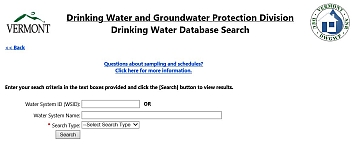All public water systems must perform water quality monitoring to demonstrate that the water provided to customers is safe to drink. The kinds of samples that are required, the number of samples that are required, and the frequency of collection are based on the water system type, population, treatment, and water quality history. Water quality monitoring requirements for TNC water systems can be divided into two general categories: source permitting water quality monitoring and routine water quality monitoring. All water quality samples must be analyzed by a laboratory certified by the Department of Health and the results must be submitted to the DWGWPD via mail or fax if the laboratory does not report the results electronically. The Water System Identification (WSID) Number must be reported on all laboratory reporting forms.
Source Permitting Water Quality Monitoring
All water systems are required to collect water quality samples for the contaminants listed in Tables 1 and 2 below from every source that is serving the water system. These samples are required when a water system applies for a Source Water Permit from the DWGWPD to construct a new source or use an existing source to serve a TNC water system. These samples are also required when a water system has a pre-existing source that was constructed before development of the Source Permit Program. The Division may identify that these samples have not been collected during a file review performed as part of a sanitary survey, a property transfer, processing of an operating permit application, etc.
The water samples must be collected from the source before any treatment or storage, if applicable. Systems that have a storage tank or treatment system should install a source sample tap prior to these facilities. If the water system does not have treatment or storage, the samples may be collected from the first tap in the distribution system. This set of samples only needs to be collected once; however, if the result of testing for a contaminant exceeds a standard, the system may be required to treat or abandon the source at the discretion of the DWGWPD.
| Primary Contaminant | Maximum Contaminant Level (MCL) |
|---|---|
| Arsenic | 0.010 milligrams per liter (mg/L) |
| Nitrate | 10 mg/L |
| Nitrite | 1.0 mg/L |
| Total Coliform Bacteria | Absent |
| Uranium | 20 micrograms per liter (μg/L) |
| Secondary Contaminant | Secondary Maximum Contaminant Level (MCL) |
|---|---|
| Chloride | 250 milligrams per liter (mg/L) |
| Iron | 0.3 mg/L |
| Manganese | 0.05 mg/L |
| Odor | 3 threshold odor number |
| pH | 6.5 to 8.5 |
| Sodium | 250 mg/L |
Routine Water Quality Monitoring
Once the source has been permitted and water is available to the public, all public TNC water systems must conduct routine water quality monitoring to demonstrate that the water remains safe to drink over time. The majority of TNC water systems are required to conduct routine water quality monitoring for nitrate once per year and total coliform bacteria once per month or once per quarter.
Visit the Revised Total Coliform Rule page to learn more about total coliform bacteria.
Visit the Chemical Source Monitoring page to learn more about nitrate and other contaminants.
The number of nitrate and total coliform bacteria samples that a water system must collect is based on the source water type, the months of operation, and the system population. Some TNC water systems may be required to routinely sample for additional contaminants (such as petroleum products or uranium) based on local site conditions (such as geology or land use activities), historical water quality test results, or the treatment technology in use at the water system. The name of the contaminants, the number of samples, and the frequency at which the samples must be collected is identified in the system's established Monitoring Schedule. The Division provides real-time, up-to-date monitoring schedules on its website through the Monitoring Schedules tool.


